Creating pollinator pathways in your neighborhood requires connecting isolated gardens into a functioning network. Plant at least 75% native species with staggered blooming schedules across nine months, and include nesting sites like bare soil patches and bee hotels. You'll need to navigate HOA rules, source local plants, and establish community maintenance schedules. Engaging youth and organizing shared responsibilities turns individual efforts into a powerful ecological impact that transforms your entire community.
Urban Pollinator Pathways: Connecting Neighborhood Gardens
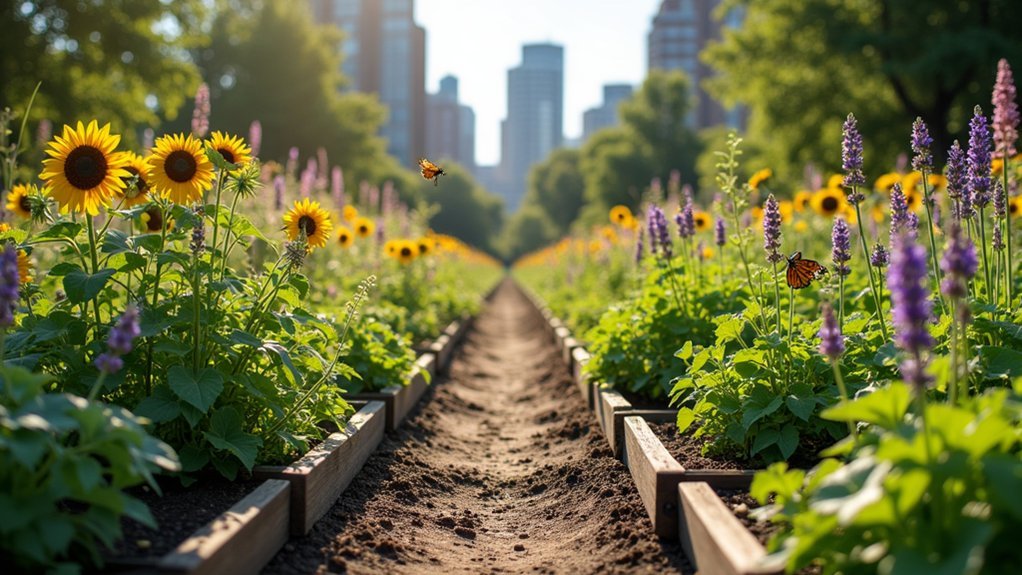
Why are isolated garden patches not enough to sustain our essential pollinators? These creatures need interconnected habitats to thrive in urban environments. Your single garden, while valuable, can't provide all the resources they require for survival.
By linking your pollinator gardens with neighbors', you're creating crucial networks that support diverse species including bees, butterflies, and hummingbirds. Research shows these pathways greatly boost pollinator populations and enhance urban biodiversity.
Even small gardens collectively make a powerful impact on ecological health. You don't need to do this alone. Collaborate with local residents and organizations to design and maintain these corridors.
This community-based approach aligns with initiatives like the Monarch and Pollinator Highway Program, turning fragmented urban spaces into thriving ecological corridors.
Native Plant Selection for Maximum Pollinator Appeal
While creating a garden might seem straightforward, choosing the right plants makes all the difference for pollinators. Aim for at least 75% native plants in your garden mix to provide essential food and habitat for local pollinator populations.
Select native flowering plants that bloom across nine months of the year, ensuring continuous nourishment for bees, butterflies, and hummingbirds. Include key species like milkweed for monarchs, echinacea for bees, and lavender for diverse pollinators.
A garden rich in diverse, seasonally-blooming native plants provides essential sustenance for critical pollinators year-round.
Research plants specifically suited to your ecoregion—these natives thrive better in local conditions and naturally attract regional pollinators.
Visit local nurseries specializing in native plants to find non-invasive species that support your local ecology. This targeted approach not only beautifies your garden but remarkably contributes to crucial pollinator conservation efforts.
Designing Multi-Season Blooms in Community Spaces
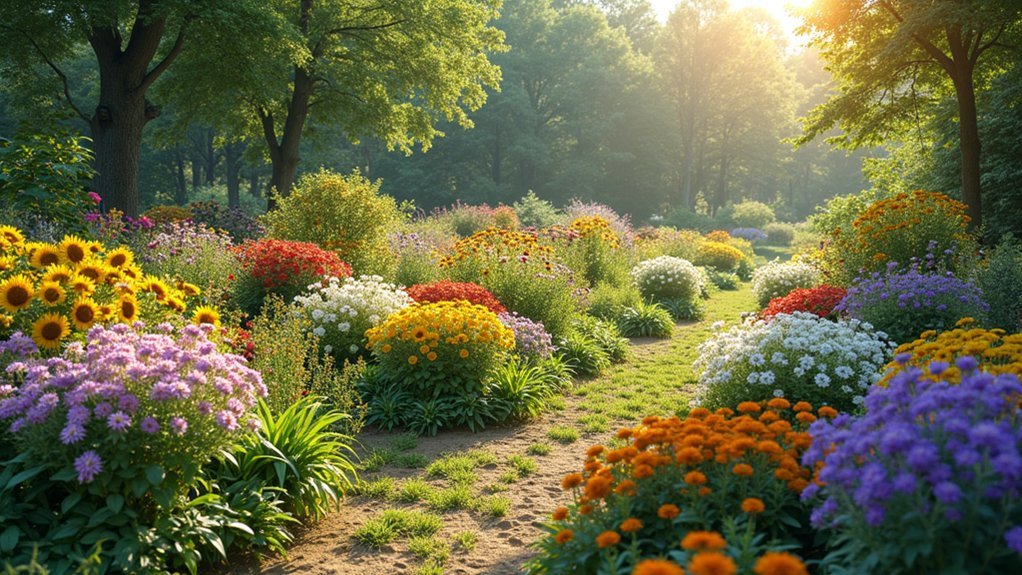
You'll need a strategic approach to planning year-round blooms in your community garden to support pollinators throughout multiple seasons.
By implementing succession planting strategies, you can guarantee nectar and pollen sources are continuously available for at least nine months of the year.
Coordinating with local nurseries to source seasonal native plants will help maintain a vibrant, pollinator-friendly space that shifts smoothly from spring through fall.
Year-Round Bloom Planning
When designing a community garden that truly supports pollinators, creating a year-round bloom schedule becomes essential for sustaining local biodiversity.
You'll need to select plants that flower across different seasons, ensuring native pollinators have consistent food sources for at least nine months annually.
- Select ecoregion-appropriate plants – Choose species adapted to your local conditions that naturally attract regional pollinators.
- Incorporate diverse flowering species – Mix plants like coneflowers, milkweed, and lavender to provide varied nectar and pollen sources.
- Implement staggered planting schedules – Time plantings so as one species finishes blooming, another begins.
- Engage community knowledge – Involve neighbors in planning discussions to maximize seasonal coverage and build collaborative ownership.
This strategic approach maintains continuous pollinator support while strengthening community bonds through shared environmental stewardship.
Succession Planting Strategy
Succession planting transforms community gardens into year-round pollinator havens through strategic timing and thoughtful plant selection. By scheduling different flowering species to bloom across seasons, you'll create continuous food sources for native pollinator species for at least nine months annually.
Incorporate native plants as the backbone of your succession strategy—they're naturally adapted to local conditions and attract indigenous pollinators that maintain ecological balance in your neighborhood. This diversity also reduces pesticide needs by fostering beneficial insect populations that control pests naturally.
Engage your community in this planning process to spread knowledge and build collective ownership. When neighbors collaborate on selecting spring, summer, and fall bloomers, they develop shared pride in creating sustainable pollinator habitat while learning practical gardening skills from one another.
Creating Nesting Sites Beyond Flower Beds
While beautiful blooms attract pollinators to your community garden, successful pollinator habitats require more than just flowers.
A garden that feeds pollinators without housing them is only half a habitat.
Most native bees need specific nesting areas to complete their lifecycle. You'll boost your garden's pollinator habitat by incorporating these simple features:
- Leave patches of bare, unmulched soil for ground-nesting bees, which represent about 70% of all bee species.
- Install bee hotels with various-sized tubes to attract solitary bees like mason and leafcutter varieties.
- Create brush piles or leave dead wood in quiet corners of your garden to provide natural shelter and nesting materials.
- Develop microhabitat diversity by maintaining areas with different sun exposure, moisture levels, and vegetation heights.
These additions transform your garden from merely feeding pollinators to fully supporting their entire lifecycle.
Building Collaborative Garden Management Systems
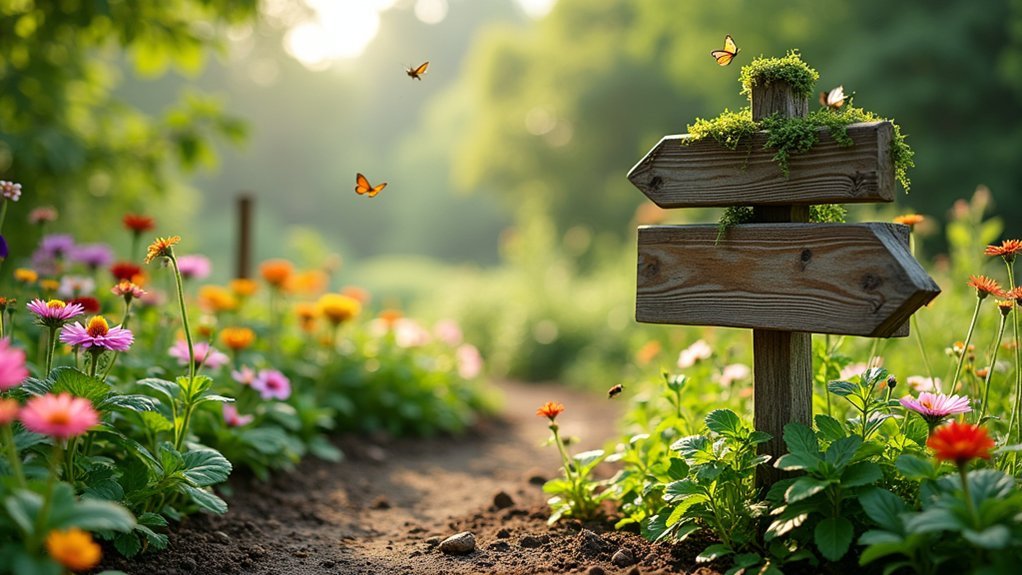
Beyond physical habitat features, the sustainability of your community pollinator garden hinges on how effectively people work together.
Establish clear roles for volunteers to guarantee consistent watering, weeding, and maintenance throughout the growing season.
Schedule regular community meetings where members can share successes and challenges related to pollinator attraction and support. These gatherings foster a sense of shared ownership and responsibility for your garden's health.
Implement a shared calendar for planting schedules, maintenance tasks, and educational workshops to synchronize community efforts. This simple tool helps coordinate activities and increases engagement in your pollinator initiatives.
Embrace the diversity of gardening experience among your neighbors—veterans and beginners alike contribute valuable knowledge and skills that enhance your garden's ability to support local pollinators.
Tracking Pollinator Diversity in Urban Settings
Although urban environments present unique challenges for pollinators, they offer surprising opportunities for biodiversity monitoring and conservation. Your city spaces can support up to 40% of local bee species when properly designed with native plants and connected green areas.
You'll find tracking urban pollinators beneficial through:
- Increased biodiversity – well-planned gardens boost bee diversity by up to 50%
- Improved garden planning – monitoring helps identify which plants attract the most diverse pollinators
- Community engagement – citizen science initiatives connect residents with local ecosystems
- Habitat connectivity – tracking helps identify where to create ecological corridors between fragmented spaces
Engaging Youth Through Pollinator Education
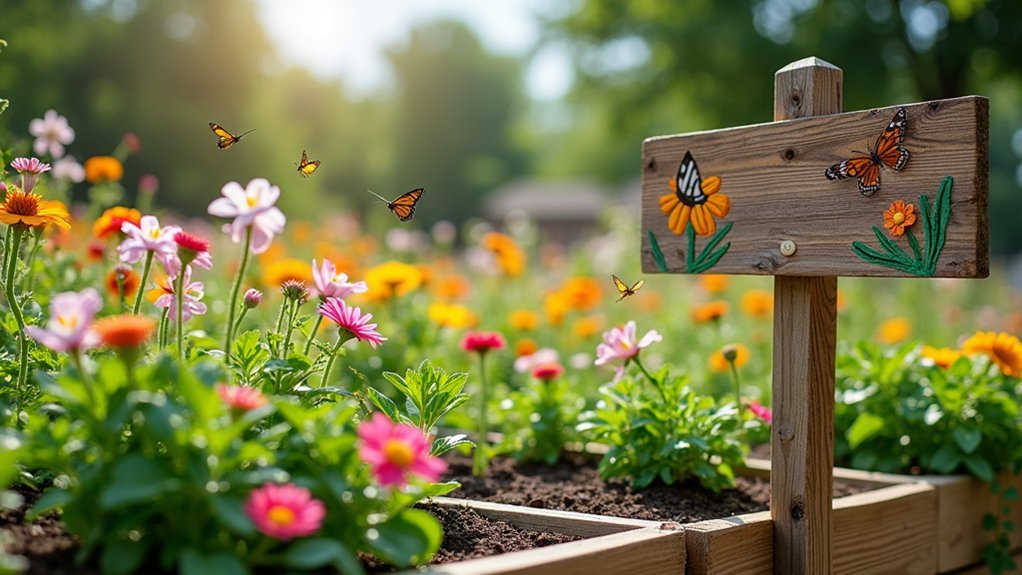
Your young gardeners can lead meaningful pollinator initiatives by designing and maintaining dedicated sections of community gardens that attract local butterflies and bees.
You'll find that children enthusiastically embrace hands-on learning when they can plant seeds, observe insect visitors, and create simple identification guides for the pollinators they encounter.
Through these engaging activities, you're not only teaching environmental stewardship but also empowering the next generation to take action for biodiversity in their own neighborhoods.
Youth-Led Garden Initiatives
When young people take charge of pollinator gardens, they develop a profound connection to the natural world while building valuable leadership skills.
Youth-led garden initiatives transform communities while teaching vital environmental stewardship.
You'll see remarkable benefits when supporting these projects:
- Young gardeners gain firsthand experience with the critical role pollinators play in producing 75% of our food crops.
- Students develop practical gardening skills while planting native flowers that create essential pollinator habitats.
- Participants become environmental advocates, inspiring community-wide conservation efforts.
- These Pollinator Garden projects foster biodiversity right in your neighborhood, with visible improvements to local ecosystem health.
Hands-On Learning Activities
Building on the enthusiasm sparked by youth-led initiatives, experiential learning activities transform abstract environmental concepts into tangible discoveries for young participants.
When you guide children to plant Bee Friendly gardens, you're teaching them that 75% of our food crops depend on pollinators for survival.
Encourage youth to create art projects using native plants or organize a community workshop where they can collaborate on pollinator conservation.
The Find Your Roots Tool helps them select appropriate regional flora, deepening their understanding of local ecosystems.
Set concrete goals like establishing pollinator habitats of at least 100 square feet.
These measurable objectives empower children to take meaningful action in their neighborhoods while developing environmental stewardship skills.
Through hands-on engagement, you'll nurture the next generation of pollinator advocates.
Overcoming HOA and City Ordinance Challenges
Despite their environmental benefits, community pollinator gardens often face regulatory hurdles from both HOAs and city governments.
While essential for our ecosystem, community pollinator gardens must navigate complex HOA rules and municipal regulations to flourish.
When you're addressing these challenges, follow these proactive steps:
- Review HOA guidelines before planning your garden to guarantee compliance with existing landscaping rules and identify potential conflicts.
- Engage early with HOA leadership to discuss your pollinator garden plans, emphasizing aesthetic benefits that align with neighborhood standards.
- Check city ordinances and obtain permits where required, as many municipalities have specific zoning laws governing community gardens.
- Form a neighborhood coalition to approach officials collectively, demonstrating community support while educating them about pollinator gardens' ecological and beautification benefits.
Sourcing Local Seeds and Plants for Garden Networks
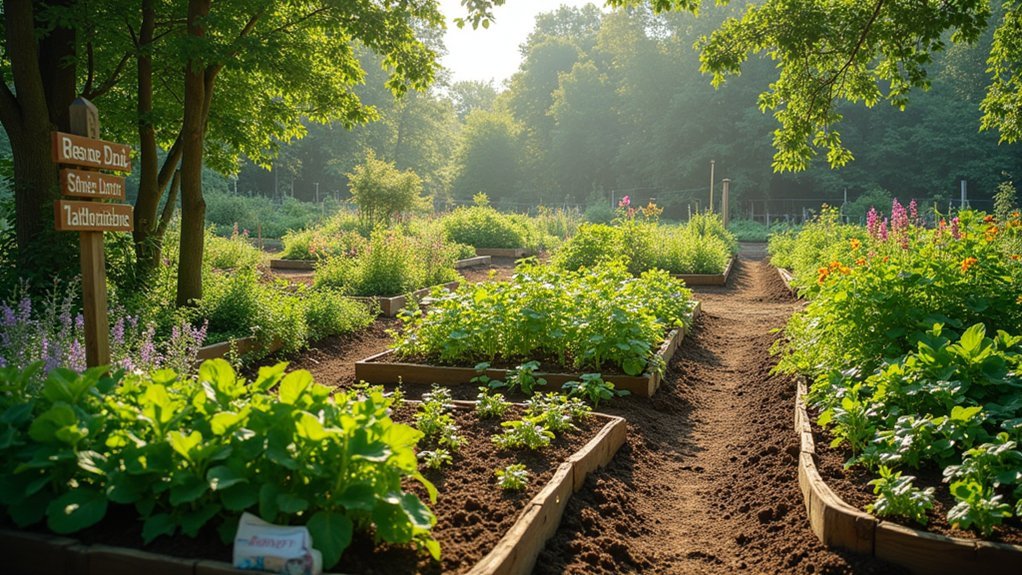
You'll find exceptional value at local garden centers that stock native plants specifically adapted to your region's growing conditions and pollinator needs.
Community seed exchange events offer opportunities to acquire diverse plant varieties while connecting with fellow gardeners who can share knowledge about successful pollinator-friendly species in your area.
These collaborative networks not only reduce your gardening costs but also strengthen community resilience by creating interconnected habitats that support local pollinator populations.
Garden Center Advantages
Local garden centers serve as essential hubs for community gardens seeking to enhance pollinator habitats.
When you shop at these neighborhood businesses, you're gaining access to native plant selections that thrive in your specific climate and soil conditions.
Your garden benefits in four key ways:
- Climate-adapted plants that require less maintenance and have higher survival rates
- Expert guidance from knowledgeable staff who understand local growing conditions
- Reduced carbon footprint by eliminating long-distance shipping of plants and seeds
- Economic support for local businesses while accessing potential discounts on seasonal items
Seed Exchange Events
Numerous seed exchange events have transformed how community gardeners source materials for pollinator-friendly spaces. By participating in these gatherings, you'll gain access to locally-adapted varieties that thrive in your specific growing conditions while supporting native pollinators.
Your local Native Plant Society often coordinates these exchanges, connecting you with fellow gardeners who share heirloom and indigenous plant varieties. These connections go beyond mere seed swapping—they foster valuable discussions about pollinator-friendly gardening techniques unique to your region.
Trading locally-sourced seeds reduces dependence on commercial nurseries that may sell non-native or potentially invasive species. This community-based approach enhances your garden's resilience by diversifying plant options that support various pollinators throughout the growing season.
The result: stronger ecological networks and more vibrant community gardens.
Water Conservation Strategies for Pollinator Gardens
While creating a thriving habitat for pollinators remains the primary goal of community gardens, water conservation should be equally prioritized in today's climate-conscious world.
Balancing pollinator support with water responsibility represents the new gold standard for community gardening excellence.
Implementing effective water conservation strategies doesn't have to compromise your garden's ability to support bees, butterflies and other essential pollinators.
- Install rainwater harvesting systems like rain barrels to collect free water for irrigation needs.
- Apply a layer of mulch around plants to retain moisture, reduce evaporation, and control unwanted weeds.
- Switch to drip irrigation that delivers water directly to roots, minimizing waste while maximizing plant health.
- Practice hydrozoning by grouping plants with similar water requirements together, and prioritize native species that naturally require less water once established.
Celebrating Pollinator Success Through Community Events
As your garden buzzes with renewed life and activity, hosting community events becomes an excellent way to showcase pollinator success stories and inspire broader participation.
Mark your calendar for Pollinator Week (June 16-22, 2025) to organize celebrations that highlight local conservation achievements.
Plan collaborative gardening activities where neighbors can exchange knowledge about native plants while working together to enhance pollinator habitats.
Host educational workshops demonstrating how these habitats support diverse pollinator populations.
Don't forget to recognize community members who've made significant contributions to local gardens.
These acknowledgments create pride and motivate continued involvement in conservation efforts.
When you celebrate garden successes publicly, you'll create a ripple effect that promotes biodiversity and encourages environmental stewardship throughout your neighborhood.
Frequently Asked Questions
How Do I Turn My Yard Into a Pollinator Garden?
To turn your yard into a pollinator garden, plant 75% native flowers that bloom across seasons, create a 100+ square-foot space, avoid pesticides, add water sources, and include host plants for butterfly larvae.
What Is the #1 Pollinator?
While honeybees are often considered the #1 pollinator, supporting $15 billion in U.S. crops annually, you'll find they're just one star in a diverse cast that includes native bees, butterflies, and hummingbirds.
What Time of Year Should I Plant My Pollinator Garden?
Plant your pollinator garden in spring after the last frost to establish roots before summer heat. Fall's also good for native perennials, giving them time to settle before winter and benefit from spring moisture.
What Is the Best Landscaping for Pollinators?
The best landscaping for pollinators includes diverse native plants blooming throughout seasons. You'll want 75% native species, milkweed, coneflowers, and lavender. Avoid pesticides and provide various plant structures for different pollinator needs.
In Summary
You've got everything you need to transform your neighborhood into a pollinator paradise. By connecting gardens, choosing native plants, and working together, you're not just growing flowers—you're building ecological corridors and stronger communities. Don't let regulations discourage you; instead, rally your neighbors and celebrate your shared successes. Together, you're creating a sustainable habitat network that'll benefit pollinators for generations to come.





Leave a Reply